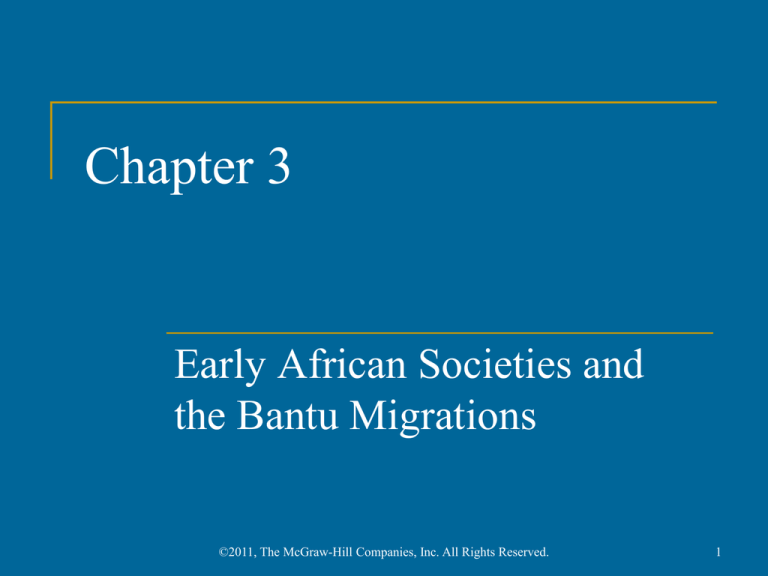
Chapter 3
Early African Societies and
the Bantu Migrations
©2011, The McGraw-Hill Companies, Inc. All Rights Reserved.
1
Development of African Agriculture
Sahara desert originally highly fertile region
Western Sudan region nomadic herders, ca. 9000
B.C.E.
Domestication of cattle ca. 7500 B.C.E.
Later, cultivation of sorghum, yams, increasingly
diverse
Widespread desiccation of the Sahara ca. 5000
B.C.E.
©2011, The McGraw-Hill Companies, Inc. All Rights Reserved.
2
The Gift of the Nile
Gradual, predictable
flooding
Alluvial deposits support
productive agricultural
society
“Gift of the Nile”
©2011, The McGraw-Hill Companies, Inc. All Rights Reserved.
3
Early Agriculture in Nile Valley
10,000 B.C.E. migrants from Red Sea hills
(northern Ethiopia)
Introduce collection of wild grains, language roots of
Coptic
5000 B.C.E. Sudanic cultivators, herders migrate
to Nile River valley
Adaptation to seasonal flooding of Nile through
construction of dikes, waterways
Villages dot Nile by 4000 B.C.E.
©2011, The McGraw-Hill Companies, Inc. All Rights Reserved.
4
Impact on Political Organization
As in Mesopotamia, a need for formal
organization of public affairs
Need to maintain order and organize community
projects
Egypt: simple, local irrigation projects
Rural rather than heavily urban development
Trade networks develop
©2011, The McGraw-Hill Companies, Inc. All Rights Reserved.
5
Unification of Egypt
Legendary conqueror Menes, ca. 3100, unifies
Egyptian kingdom
Sometimes identified with Narmer
Tradition: founder of Memphis, cultural and political
center of ancient Egypt
Instituted the rule of the pharaoh
Claimed descent from the gods
Absolute rulers, had slaves buried with them from 2600 B.C.E.
Most powerful during Archaic Period (3100-2660 B.C.E.)
and Old Kingdom (2660-2160 B.C.E.)
©2011, The McGraw-Hill Companies, Inc. All Rights Reserved.
6
The Pyramids
Symbols of the pharaoh’s
authority and divine
status
A testimony of the
pharaohs’ ability to
marshal Egypt’s
resources
Largest Khufu (Cheops),
2.3 M limestone blocks,
average weight 2.5 tons
Role: burial chambers for
pharaohs
©2011, The McGraw-Hill Companies, Inc. All Rights Reserved.
7
Relations with Nubia
Competition over Nile trade
Military conflict between 3100 and 2600 B.C.E.
Drove Nubians to the south
Established kingdom of Kush, ca. 2500 B.C.E.
Trade, cultural influences continue despite
military conflict
©2011, The McGraw-Hill Companies, Inc. All Rights Reserved.
8
The New Kingdom
Few pyramids, but major
monumental architectural
projects
Engaged in empire-building to
protect against foreign
invasion
After New Kingdom, local
resistance drives Egypt out of
Nubia
Kingdom of Kush revives
ca. 1100 B.C.E.
Invasions of Kushites,
Assyrians destroy Egypt
mid-sixth century B.C.E.
©2011, The McGraw-Hill Companies, Inc. All Rights Reserved.
9
Egyptian Urban Culture
Major cities along Nile River, especially at delta
Nubian cities include Kerma, Napata, Meroë
Memphis ca. 3100 B.C.E., Heliopolis ca. 2900 B.C.E.
Located at cataracts of the Nile
Well-defined social classes
Pharaohs to slaves
Archaeological discoveries in Nubia also support classbased society
Patriarchal societies, notable exceptions: female
pharaoh Hatshepsut (r. 1473-1458 B.C.E.)
©2011, The McGraw-Hill Companies, Inc. All Rights Reserved.
10
Economic Specialization
Bronze metallurgy introduced late, with Hyksos
invasion
Development of iron early, ca. 900 B.C.E.
Trade along Nile River
More difficult in Nubia due to cataracts
Sea trade in Mediterranean
©2011, The McGraw-Hill Companies, Inc. All Rights Reserved.
11
Hieroglyphs
“Holy inscriptions”
Writing appeared at least by 3200 B.C.E.
Pictographic, supplemented with symbols
representing sounds and ideas
Survives on monuments, buildings, and sheets of
papyrus
Hieroglyphs for formal writing, hieratic script for
everyday affairs used from 2600 B.C.E. to 600 C.E.
Greek alphabet adopted – demotic and Coptic scripts
Meroitic writing: flexible system borrowed from
hieroglyphs, represents sounds rather than ideas
©2011, The McGraw-Hill Companies, Inc. All Rights Reserved.
12
Development of Organized Religious
Traditions
Principal gods Amon and Re
Religious tumult under Amenhotep IV
(Akhenaten) (r. 1353-1335 B.C.E.)
Introduces sole worship of sun god Aten
One of the world’s earliest expressions of monotheism
Death of Akhenaten, traditional priests restore the
cult of Amon-Re to privileged status
©2011, The McGraw-Hill Companies, Inc. All Rights Reserved.
13
Mummification and the Afterlife
Inspiration of the cycles of the Nile
Belief in the revival of the dead
Cult of Osiris
First: ruling classes only, later expanded to include
lower classes
Lord of the underworld
Power to determine who deserved immortality
Held out hope of eternal reward for those who lived
moral lives
Nubian worship of Apedemak and Sebiumeker
©2011, The McGraw-Hill Companies, Inc. All Rights Reserved.
14
Bantu Migrations, 3000-1000 B.C.E.
Bantu: “people”
Migration throughout sub-Saharan regions
Over 500 variations of original Bantu language
Population pressures
90 million speakers
By 1000 B.C.E., occupied most of Africa south of
the equator
©2011, The McGraw-Hill Companies, Inc. All Rights Reserved.
15
Bantu Migrations, 2000 B.C.E.-1000 C.E.
©2011, The McGraw-Hill Companies, Inc. All Rights Reserved.
16
Bantu Religions
Evidence of early monotheism
Deistic views as well
Prayers to intercessors, e.g. ancestor spirits
Great variations among populations
©2011, The McGraw-Hill Companies, Inc. All Rights Reserved.
17




